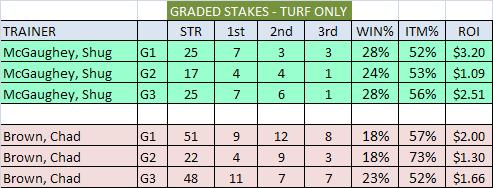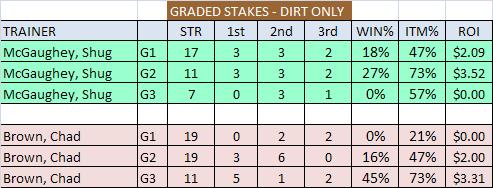Know Your Trainers – Shug McGaughey vs. Chad Brown
A frequent question asked by new fans trying to learn more about horse racing is, “Where do I begin?” My immediate response is generally, “Get to know your trainers.” While learning about topics like distance, class, and pace are important … in my opinion, none are as important as learning about the tendencies, strengths, and weaknesses of trainers. With that thought in mind, we continue our series of articles called “Know Your Trainers.”
In this series we will dig into the statistics of some head trainers and try to make sense of the numbers we find. We thought it might be fun to present the numbers in a “competitive” manner by pairing trainers. With that said, we are not trying to judge the trainers or claim that one is better than another. Our intention is to pair trainers who have statistics in comparable categories and present some plausible reasons why they might differ.
So let’s continue with two of the big names in the business, Shug McGaughey and Chad Brown. Our focus will be on two main areas; Graded Stakes and 2-Year old horses, with a couple of extras that we uncovered by surprise. We limited the data to the past two years, with the exception of Graded Stakes Dirt races for Shug, where we included three years to get a comparable data sample.
Before we start, here is an explanation of each column in the charts below:
- STR = Number of starts
- 1st = Number of wins.
- 2nd = Number of place finishes.
- 3rd = Number of show finishes.
- WIN% = Overall percentage of wins based on number of starts.
- ITM% = Percentage of times the horse finished In-The-Money (1st, 2nd, or 3rd).
- ROI = Return on Investment, based on a $2 flat Win bet for every starter. Over $2 is profitable. For example, if there were 100 starters, and the ROI was $3 … The total wagered would equal $200 ($2 x 100). The return would be $300 ($3 x 100). If the ROI were $0.50, then the return would be $50 (50-cents x 100) … resulting in a loss of $150.
Our first comparison will be in a category that both trainers are traditionally very strong in, that’s Graded Stakes races on the grass. Below is the results for each trainer, separated by the level of Graded Stakes (Grade 1, 2, 3).
 The first thing that pops out is the consistency of Shug’s percentages both in terms of Win (24-28%) and In-The-Money (52-56%) for all three levels of Graded Stakes. Looking at just the Grade-3 results for Shug, you see that 13 of 25 finished first or second. That’s more than 50% in the exacta. Good information to consider when constructing your Intra-race wagers.
The first thing that pops out is the consistency of Shug’s percentages both in terms of Win (24-28%) and In-The-Money (52-56%) for all three levels of Graded Stakes. Looking at just the Grade-3 results for Shug, you see that 13 of 25 finished first or second. That’s more than 50% in the exacta. Good information to consider when constructing your Intra-race wagers.
Chad Brown’s percentages are comparable, with his Win% being slightly lower. Digging into the results further, we found that of the twelve 2nd place finishes in Grade-1 Stakes, eight were by less than 1-length. Also, of the nine 2nd place finishes in Grade-2 Stakes, six were also less than 1-length. This suggests that with a little better racing luck, both his Win% and ROI could have been much higher.
Next we’ll look at Graded Stakes races on the dirt. Here is the chart:
On balance, Shug’s numbers on dirt are similar to his Graded Stakes results on grass with one exception. He has had very few Grade-3 races on the dirt. However, his ROI in both G1/G2 races makes him a solid bet. Chad Brown’s results in Grade-1 races indicate he does not have many Grade-1 Dirt horses in his stable at this time. His results improve dramatically in Grade-2 dirt races, with nearly 50% finishing in the exacta. And finally, in Grade-3 races he has been super, winning 45% of those, with a solid ROI of $3.31.
At this time of year, the 2-year old races are in full swing. For that reason, we will look at our trainer’s records in 2-year old dirt races. We separated them further by Sprint (Spr) and Route (Rt) distances. Here are the results:
Their results with 2-year old sprinters is nearly identical across the board. This suggests both of our trainers have a similar philosophy when it comes to running babies in dirt sprint races. If they are good enough to win on their own, then great. But more times than not, these juvenile races are just stepping stone to races down the road.
In the route category, Shug’s percentages don’t change much, though his ROI is a little better. Chad Brown’s numbers tell a different story. By any measure, winning 27% and 68% in-the-money are extraordinary results. However, his ROI of $1.53 suggests the his horses are being seriously over bet for these juvenile dirt route races. His high ITM% suggests it’s a good idea to back him in exotics, but his low ROI makes him an unprofitable play in the Win pool.
The next two categories are a little out of the ordinary, but are quite interesting and can be quite profitable. The first shows how our two trainers do in “marathon” races. For the purpose of this study, we define a marathon as any race having a distance of 10 furlongs (11/4 mile) or more.
To be honest, I did a double-take when I looked at these results. Having researched trainer statistics for marathon races for quite awhile, the Win%, ITM%, and ROI for these two trainers are unmatched by any other major trainer. In fact, in searching the records of nearly thirty other trainers, no even came close. Whatever Shug McGaughey and Chad Brown are doing to prepare their horses to run long, it’s working.
The final category we will review has a small amount of data, but in the case of one of our trainers, indicates that he is very dangerous when his horses fall under this category – First time in for a Claiming Tag. Click here to learn more about claiming races.
It’s obvious that Shug enters far less horses into claiming races than Chad and his results suggest these horses are generally lacking in ability. Chad’s results are exactly the opposite. He wins 50% of the time and hits the exacta 2 out of every 3 races he drops a horse in for a tag. Out of these thirty horses, twelve were claimed by another trainer out of the race. This infers that Chad is fully prepared to put horses in spots where they might be claimed, but compensates for the loss of the horse with purse money earned in the majority of the cases. That is the definition of a “well-meant” horse.
————————————————————
Below are two prior “Know Your Trainer” articles. Click on their names to read the article.
Christophe Clement vs. Graham Motion
Modeled after European style turf courses, come visit the only one of its kind in North America. The author had a truly enjoyable visit to this unique race course in 2013. Click here to read more about that adventure.
Saturday, September 13 will have four Stakes Races, including the Grade 3 Kentucky Turf Cup worth $600,000.






2 comments on “Know Your Trainers – Shug McGaughey vs. Chad Brown”